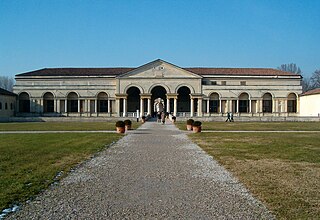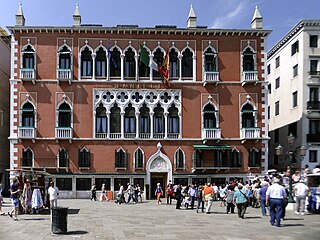
A balcony is a platform projecting from the wall of a building, supported by columns or console brackets, and enclosed with a balustrade, usually above the ground floor. They are commonly found on multi-level houses, apartments and cruise ships.

Palazzo Farnese or Farnese Palace is one of the most important High Renaissance palaces in Rome. Owned by the Italian Republic, it was given to the French government in 1936 for a period of 99 years, and currently serves as the French embassy in Italy.

Palazzo del Te, or simply Palazzo Te, is a palace in the suburbs of Mantua, Italy. It is an example of the mannerist style of architecture, and the acknowledged masterpiece of Giulio Romano.

Iesi is a comune (municipality) in the province of Ancona, in the Italian region of Marche.

Sicilian Baroque is the distinctive form of Baroque architecture which evolved on the island of Sicily, off the southern coast of Italy, in the 17th and 18th centuries, when it was part of the Spanish Empire. The style is recognisable not only by its typical Baroque curves and flourishes, but also by distinctive grinning masks and putti and a particular flamboyance that has given Sicily a unique architectural identity.

The Palazzo Spada is a palace located on Piazza di Capo Ferro #13 in the rione Regola of Rome, Italy. Standing very close to the Palazzo Farnese, it has a garden facing towards the Tiber river.
The Zacco family originated from Spain, where they are first recorded in when Stefano Zacco was a councillor of King Alfonso II of Aragon in the 12th century.

A putto is a figure in a work of art depicted as a chubby male child, usually naked and very often winged. Originally limited to profane passions in symbolism, the putto came to represent a sort of baby angel in religious art, often called cherubs, though in traditional Christian theology a cherub is actually one of the most senior types of angel.

Piazza Armerina is a comune in the province of Enna of the autonomous island region of Sicily, southern Italy.

Palazzo Labia is a baroque palace in Venice, Italy. Built in the 17th–18th century, it is one of the last great palazzi of Venice. Little known outside of Italy, it is most notable for the remarkable frescoed ballroom painted 1746–47 by Giovanni Battista Tiepolo, with decorative works in trompe-l'œil by Gerolamo Mengozzi-Colonna.

Giovanni da San Giovanni, also known as Giovanni Mannozzi, was an Italian painter of the early Baroque period, active in Florence.

Palazzo Borghese is a palace in Rome, Italy, the main seat of the Borghese family. It was nicknamed il Cembalo due to its unusual trapezoidal groundplan; its narrowest facade faces the River Tiber. The entrance at the opposite end of the building, the "keyboard" of the cembalo, faces onto the Fontanella di Borghese, with another in a great flanking facade to the Piazza Borghese that is extended by a slightly angled facade leading down Via Borghese towards the river. Both these entrances lead into a large courtyard on one side of which is a two level open arcade, with paired Doric and Ionic columns, that frames the garden beyond.

The Palazzo Porto is a palace in Piazza Castello, Vicenza, northern Italy. It is one of two palazzi in the city designed by Andrea Palladio for members of the Porto family. Only two bays of it were ever built, beginning shortly after 1571. Why the patron, Alessandro Porto, did not continue with the project is not known.

Palazzo Zuccari, also called Palazzetto Zuccheri, is a 16th-century residence, located at the crossroads of via Sistina and via Gregoriana, with a Mannerist 16th-century facades on the latter street and a late Baroque facade on the piazza Trinità dei Monti in the Campo Marzio neighborhood of Rome, Italy. Designed by Federico Zuccari, the house is known locally as the "House of Monsters" for the decorations on its doors and windows overlooking the via Gregoriana.

The Hotel Danieli is a palatial five-star hotel in Venice, Italy. The central wing of the hotel was built as the Palazzo Dandolo at the end of the 14th century, by one of the Dandolo families. CNN cites it as one of the top five "lavish hotels" in the city.

Piazza d'Aracoeli is a square of Rome (Italy), placed at the base of the Capitoline Hill, in the Rione X Campitelli.

Palazzo Corner della Regina, commonly known as Ca' Corner della Regina, is a Baroque-style palace in the Sestiere Santa Croce of the city of Venice, Italy. In the English language, the title conforms with Palace of the Queen from the "Corner Family"; it is so named because Caterina Cornaro, who became Queen of Cyprus by marriage, was born to this family and at this site in 1454. The palace is located on the Grand Canal, near Ca' Pesaro, and between Ca' Favretto and Palazzo Correggio. The opposite structure is Palazzo Contarini Pisani.

Palazzo Cesi-Armellini, sometimes known plainly as Palazzo Cesi, is a late Renaissance building in Rome. It is considered important for historical and architectural reasons. The palace, which should not be confused with Palazzo Cesi-Gaddi, Palazzo Muti-Cesi, or the destroyed Palazzo Cesi, placed also in Borgo near the southern Colonnade of St. Peter's square, is one of the few Renaissance buildings of the rione Borgo to have survived the destruction of the central part of the neighborhood due to the 20th century construction of Via della Conciliazione, the avenue leading to St. Peter's Basilica. Today, it is owned by the Society of the Divine Savior and part of it is used as their motherhouse.

Palazzo Michiel del Brusà is a palace located in Venice, more precisely in the Cannaregio district, and overlooking the Grand Canal. The building is located between Palazzo Michiel dalle Colonne and Palazzo Smith Mangilli Valmarana.
Palazzo Lantiere is a palace, with a main facade on Via Roma #152-158, in the island of Ortigia in Siracusa, region of Sicily, Italy. A few houses east of Palazzo Bellomo on Via Roma, it presently serves as bed and breakfast.


















